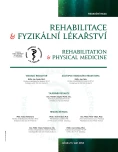Examination of cardiovascular reactivity in patients with hereditary neuropathy
Authors:
O. Horáček 1,3; D. Jílková 2; M. Matouš 2,3; R. Mazanec 4; J. Nedělka 5; P. Kolář 3; T. Nedělka 4,5
Authors‘ workplace:
Rehabilitační centrum Nemocnice Beroun, lékařský ředitel MUDr. J. Calta
1; Institut sportovního lékařství, ředitel MUDr. J. Dostal, primář MUDr. M. Matouš
2; Klinika rehabilitace a tělovýchovného lékařství 2. LF UK a FN Motol, Praha, přednosta prof. PaedDr. P. Kolář, Ph. D.
3; Neurologická klinika dospělých, FN Motol, přednosta doc. MUDr. P. Marusič, Ph. D.
4; Rehabilitace Nedělka – Poliklinika Řepy, Praha, primář MUDr. J. Nedělka
5
Published in:
Rehabil. fyz. Lék., 21, 2014, No. 3, pp. 130-135.
Category:
Original Papers
Overview
The hereditary motor and sensitive neuropathy, morbus Charcot Marie Tooth, is one of the most common neuromuscular diseases in the world. In recent years a proofs suggesting, that illness has an autonomic component were found. On a group of 17 patients suffering from Charcot Marie Tooth disease we executed a study focused on the examination of autonomic nervous system. For the most of patients, the symptoms of autonomic neuropathy were proved. Some of examined patients described subjective problems, especially gastrointestinal and sudomotor troubles. The autonomic neuropathy is also risk factor of cardiovascular morbidity, which is in relation with motor handicap and common deconditioning of patients with neuropathy important factor in deteriorating quality of life and health.
Keywords:
hereditary motor and sensitive neuropathy; morbus Charcot Marie Tooth; autonomic neuropathy; heart rate variability; spiroergometry; six minute walk test; International physical activity questionnaire; CMT Neuropathy score
Sources
1. AGELINK, M. W., MALESSA, R., BAUMANN, B., MAJEWSKI, T., AKILA, F., ZEIT, T., ZIEGLER, D.: Standardized tests of heart rate variability: normal ranges obtained from 309 healthy humans, and effects of age, tender, and heart rate. Clinical Autonomic Research, 11, 2001, 2, s. 99-108, ISSN: 0959 – 9851.
2. BROOKS, A. P.: Abnormal vascular reflexes in Charcot-Marie-Tooth disease. Journal of Neurology, Neurosurgery and Psychiatry, 43, 1980, 4, s. 348-350, ISSN: 0022-3050.
3. ENRIGHT, P. L., SHERRILL, D. L.: Reference equations for the six-minute walk in healthy adults. American Journal of Respiratory and Critical Care Medicine, 158, 1998, 5, s. 1384-1387, ISSN: 1073-449X
4. FRÁŇA, P., SOUČEK, M., ŘIHÁČEK, I., BARTOŠÍKOVÁ, L., FRÁŇOVÁ, J.: Hodnocení variability srdeční frekvence, její klinický význam a možnosti ovlivnění. Farmakoterapie, 2005, 4, s. 375-377, ISSN: 1801-1209.
5. KELLER, O., RIDZOŇ, P., VONDROVÁ, H.: Polyneuropatie. Postgraduální Medicína, 2001, 5, s. 501-509, ISSN: 1212-4184.
6. MAZANEC, R., HORÁČEK, O., KOBESOVÁ, A., SMETANA, P.: Hereditární neuropatie. Česká a slovenská neurologie a neurochirurgie, 75/105, 2009, 1, s. 5-17, ISSN: 1210-7859.
7. MAZANEC, R., VYHNÁLEK, M., MARČIŠOVÁ, H., SEEMAN, T., BOJAR, M., NEDĚLKA, T.: Autonomic dysfunction in hereditary neuropathy CMT. Journal of Peripheral Nervous System, 14, 2009, 14, Suppl. 2, s. 98, ISSN: 1085-9489,
8. MCDONALD, C. M.: Physical aktivity, health impairments and disability in neuromuscular disease. American Journal of Physical Medicine and Rehabilitation, 81, 2002, 11 (Suppl), s. 108-120, ISSN: 0894-9115.
9. MISRA, U. K., KALITA, J., NAIR, P.: Diagnostic approach to peripheral neuropathy. Annals of Indian Academy of Neurology, 11, 2008, 2, s. 89-97, ISSN: 0972-2327.
10. NEVŠÍMALOVÁ, S.: Hereditární polyneuropatie. In Jedlička, P., Keller, O.: Speciální neurologie. Praha, Galén, 2005, 424 s., ISBN 80-7262-312-5.
11. OPAVSKÝ, J.: Autonomní nervový systém a diabetická autonomní neuropatie. Praha, Galén, 2002, 304 s., ISBN: 80-7262-194-7.
12. SCHERER, S.: Finding the causes of inherited neuropathies. Archives of Neurology, 63, 2006, 6, s. 812.
13. VANCE, J. M., SPEER, M. C., STAJICH, J. M., WEST, S., WOLPERT, C., GASKELL, P., LENNON, F., TIM, R. M., ROZEAR, M., OTHMANE, K. B.: Misclassification and linkage of hereditary sensory and autonomic neuropathy type 1 as Charcot-Marie-Tooth disease, type 2B. American Journal of Human Genetics, 59, 1996, 1, s. 258-262, ISSN: 0002 – 9297.
14. VINCI, P., ESPOSITO, C., PERELLI, S. L., ANTENOR, J. A.V., THOMAS, F. P.: Overwork weakness in Charcot-Marie-Tooth disease. Archives of Physical Medicine and Rehabilitation, 84, 2003, 6, s. 825-827, ISSN: 0003-9993.
Labels
Physiotherapist, university degree Rehabilitation Sports medicineArticle was published in
Rehabilitation & Physical Medicine

2014 Issue 3
- Hope Awakens with Early Diagnosis of Parkinson's Disease Based on Skin Odor
- Deep stimulation of the globus pallidus improved clinical symptoms in a patient with refractory parkinsonism and genetic mutation
Most read in this issue
- Anterior Cruciate Ligament Injury – Magnetic Resonance Imaging Diagnostics and Surgical, Clinical and Rehabilitation Contexts
- Shoulder in Epitome – First Part
- Physiotherapy in a Patient after Brain Vascular Event
- Intra-Articular Healing and Graft-to-Bone Incorporation after Arthroscopic Anterior Cruciate Ligament Reconstruction
